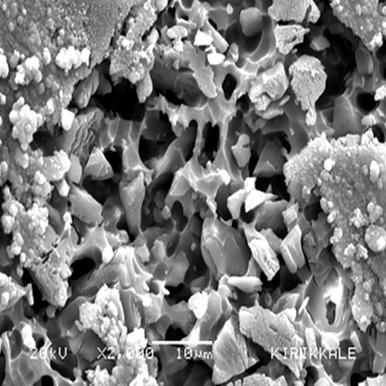当前位置:
X-MOL 学术
›
Microsc. Res. Tech.
›
论文详情
Our official English website, www.x-mol.net, welcomes your
feedback! (Note: you will need to create a separate account there.)
Repair bond strength and surface topography of resin-ceramic and ceramic restorative blocks treated by laser and conventional surface treatments
Microscopy Research and Technique ( IF 2.0 ) Pub Date : 2020-12-08 , DOI: 10.1002/jemt.23672 Yusuf Bayraktar 1 , Merve Arslan 2 , Zulfikar Demirtag 2
Microscopy Research and Technique ( IF 2.0 ) Pub Date : 2020-12-08 , DOI: 10.1002/jemt.23672 Yusuf Bayraktar 1 , Merve Arslan 2 , Zulfikar Demirtag 2
Affiliation

|
This study intended to compare the repair bond strength of computer-aided design/computer-aided manufacturing (CAD/CAM) blocks consisting of resin and feldspathic ceramics following different surface treatments using the microtensile bond strength (μTBS) test. Ten specimens were prepared with 4 mm height for Vita Enamic (VE), Lava Ultimate (LU), Vita Mark II (VM), and thermocycled (10,000 cycle, 5–55°C). Each material was categorized into one of five subgroups according to following surface treatments: (a) bur grinding (BG), (b) hydrofluoric acid etching (HF), (c) neodymium-doped yttrium aluminum garnet (Nd:YAG or NY), (d) erbium-doped yttrium aluminum garnet (Er:YAG or EY), and (e) erbium, chromium-doped yttrium, scandium, gallium, and garnet (Er,Cr:YSGG or ECY) laser conditioning. After surface treatment procedures, specimens were properly restored to 4 mm high with a micro-hybrid composite resin. Bar specimens (1 × 1 × 8 mm) were obtained using a low-speed cutting machine and then thermocycled (10,000 cycle, 5–55°C). The μTBS was tested at 1 mm/min crosshead speed, and failure modes were evaluated. Data were analyzed with two-way ANOVA and post hoc Tukey tests. LU-BG showed significantly higher μTBS (32.94 ± 5.80 MPa) compared to LU-laser groups (p < .05). VE-BG showed significantly higher μTBS (22.06 ± 4.26 MPa) compared to other VE groups (p < .05). Among the laser groups, the NY laser produced the lowest (p < .05) μTBS for LU (13.42 ± 3.44 MPa) and VE (2.27 ± 0.85 MPa), while EY showed the highest (p < .05). Laser-treated VM groups were all prefailured. VM-HF produced a higher μTBS (18.73 ± 3.75 MPa) than VM-BG (5.05 ± 1.76 MPa) (p < .05).
中文翻译:

通过激光和常规表面处理处理的树脂-陶瓷和陶瓷修复块的修复结合强度和表面形貌
这项研究旨在使用微拉伸粘结强度(μTBS)测试来比较由树脂和长石陶瓷组成的计算机辅助设计/计算机辅助制造(CAD / CAM)块的修复粘结强度。准备了10个标高为4 mm的样品,分别用于Vita Enamic(VE),Lava Ultimate(LU),Vita Mark II(VM)和热循环(10,000个循环,5-55°C)。根据以下表面处理,将每种材料分为五个子组之一:(a)bur研磨(BG),(b)氢氟酸蚀刻(HF),(c)掺钕钇铝石榴石(Nd:YAG或NY) ,(d)掺钇铝石榴石(Er:YAG或EY)和(e),掺铬铬钇,scan,镓和石榴石(Er,Cr:YSGG或ECY)激光调理。经过表面处理程序后,用微混合复合树脂将样品适当地恢复到4毫米高。使用低速切割机获得条形样品(1×1×8 mm),然后进行热循环(10,000个循环,5–55°C)。μTBS以1 mm / min的十字头速度进行测试,并评估了失效模式。使用双向方差分析和事后Tukey测试分析数据。与LU激光组相比,LU-BG显示出显着更高的μTBS(32.94±5.80 MPa)(p <.05)。与其他VE组相比,VE-BG显示出显着更高的μTBS(22.06±4.26 MPa)(p <.05)。在激光组中,NY激光的 LU(13.42±3.44 MPa)和VE(2.27±0.85 MPa)最低(p <.05)μTBS,而EY最高(p <.05)。激光治疗的VM组全部失败。VM-HF产生的μTBS(18.73±3.75 MPa)比VM-BG(5.05±1.76 MPa)高(p <.05)。
更新日期:2020-12-08
中文翻译:

通过激光和常规表面处理处理的树脂-陶瓷和陶瓷修复块的修复结合强度和表面形貌
这项研究旨在使用微拉伸粘结强度(μTBS)测试来比较由树脂和长石陶瓷组成的计算机辅助设计/计算机辅助制造(CAD / CAM)块的修复粘结强度。准备了10个标高为4 mm的样品,分别用于Vita Enamic(VE),Lava Ultimate(LU),Vita Mark II(VM)和热循环(10,000个循环,5-55°C)。根据以下表面处理,将每种材料分为五个子组之一:(a)bur研磨(BG),(b)氢氟酸蚀刻(HF),(c)掺钕钇铝石榴石(Nd:YAG或NY) ,(d)掺钇铝石榴石(Er:YAG或EY)和(e),掺铬铬钇,scan,镓和石榴石(Er,Cr:YSGG或ECY)激光调理。经过表面处理程序后,用微混合复合树脂将样品适当地恢复到4毫米高。使用低速切割机获得条形样品(1×1×8 mm),然后进行热循环(10,000个循环,5–55°C)。μTBS以1 mm / min的十字头速度进行测试,并评估了失效模式。使用双向方差分析和事后Tukey测试分析数据。与LU激光组相比,LU-BG显示出显着更高的μTBS(32.94±5.80 MPa)(p <.05)。与其他VE组相比,VE-BG显示出显着更高的μTBS(22.06±4.26 MPa)(p <.05)。在激光组中,NY激光的 LU(13.42±3.44 MPa)和VE(2.27±0.85 MPa)最低(p <.05)μTBS,而EY最高(p <.05)。激光治疗的VM组全部失败。VM-HF产生的μTBS(18.73±3.75 MPa)比VM-BG(5.05±1.76 MPa)高(p <.05)。











































 京公网安备 11010802027423号
京公网安备 11010802027423号